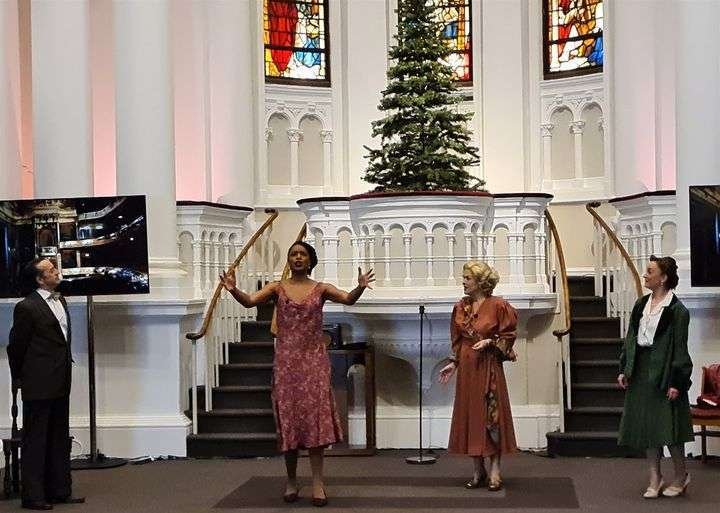
Cinderella
Image: L-R: Anton Du Beke (Buttons), Oonagh Cox (Cinderella) and Rosemary Ashe (Fairy Godmother) – Cinderella at Richmond Theatre. Photo: Benjamin Mole
You enter the auditorium dazzled by the fairy-tale front cloth ahead. And, from the moment the band strikes up, the show goes on scintillating right up to Cinderella’s wedding and the playout. If you don’t want to leave that’s partly because it’s cold outside. More importantly, you’ve been having such an enjoyable time inside. Cinderella is possibly everyone’s favourite panto. Well, it is mine. And this is a good one. It was a stroke of genius inviting Anton Du Beke to head the cast at Richmond: his affable and endearing manner makes him a natural for the role of Buttons.
I was lucky enough to see the show at an early preview. The previous day Du Beke was miles away in Elstree adjudicating back-to-back episodes of Strictly Come Dancing before making the fifty-mile journey to Richmond for a matinee and then this, only his third, performance. How does he manage to keep so buoyant? Ah, the elixir of Dr Theatre! If there was an occasional fluff, it was hard to tell if it was, as I suspect, genuine, or a carefully rehearsed gag. Either way it was used to good comic effect. I particularly liked the way he milks the audience by means of a subtle back-handed flick of his wrist – a repeated gimmick which pays dividends as the evening wears on.
But this is also an ensemble show, brilliantly coordinated in Stewart Nicholls’, as always, meticulous direction. Everyone sings and dances impeccably and enters enthusiastically into the fun. Rosemary Ashe, fresh from her recent, triumphant Sally Adams in Call Me Madam, makes the perfect Fairy Godmother: glamorous yet homely; everyone’s favourite no-nonsense aunt. Her comic timing is a joy. Oonagh Cox, in her first starring role, is a delightful Cinders: a triple threat as a strong actor-singer-dancer and surely destined to be a valuable addition to the UK’s musicals scene. Edward Chitticks’ full-throated Prince is as charming as his name and faux Eighteenth Century attire certainly sets off his good looks to best advantage.
As the Ugly Sisters, Bobby Delaney and Darren Bennett (although wasn’t it a teensy bit unkind to name them Beatrice and Eugenie?) look hideously stunning in way-OTT couture creations – a different wig for each millinery concoction. Three days prior to opening, Bennett had replaced another actor as Beatrice, but you’d never have known as the two actors work like a long-standing double act – and are two of the meanest ‘Sisters’ I’ve seen. Jonny Weston brings his own special brand of comic ineptness to the often-thankless role of Dandini.
In my youth, panto audiences were accustomed to stages spilling over with singers and dancers. These days, as here, we are down to just six. Thanks to Alan Burkitt’s imaginative choreography, however, Thomas Charles, Tom Fletcher, Nancy Harris, Natasha Scrase, Rosie Southall and Laura Swan manage to fill the stage with cheerful, swirling movement. Having Du Beke in the cast means there must be a big number to show off, both himself and the dancers. Sure enough, it comes appropriately in the Ball scene when Buttons, now in top hat, bow tie and tails, catches a cane Astaire-style and the dancers swap their old-fashioned glad rags for contemporary evening gowns. The result is an enchanting highlight of the production.
Until very recently, second houses provided panto comics with the opportunity to introduce sophisticated and/or blue humour into the script. In the interval, some of us reflected on the extent to which political correctness has affected writers of family entertainment. Panto humour was never very subtle, but you can have one fart gag too many – though, to be fair, the kids seem to love it. It is interesting to note, however, a greater and healthier reliance on verbal comedy involving accumulated misunderstandings and repetition of the ‘Old Macdonald’ variety.
Cinderella more than any other panto, needs to look and sound good. The sets and costumes here are fresh and attractive. The work of Ramon Van Stee (Sound) and Richard G Jones (Lighting) is first-rate work, as is that of Gary Hind and Pierce Tee who are responsible for the musical side of the show.
Oh, and the glittering coach and white ponies are gorgeous, darling!
It is so good to see pantomimes back in the theatre after a two-year absence. With such a promising start to the festive season in Surrey, one can only pray that the current pandemic won’t discourage audiences from attending this and other Christmas shows. It was great to shed the years and join in the chorusing along with the enthusiastic youngsters in the audience.
We had – cliché spoiler – a ball. Bravo to everyone involved!

